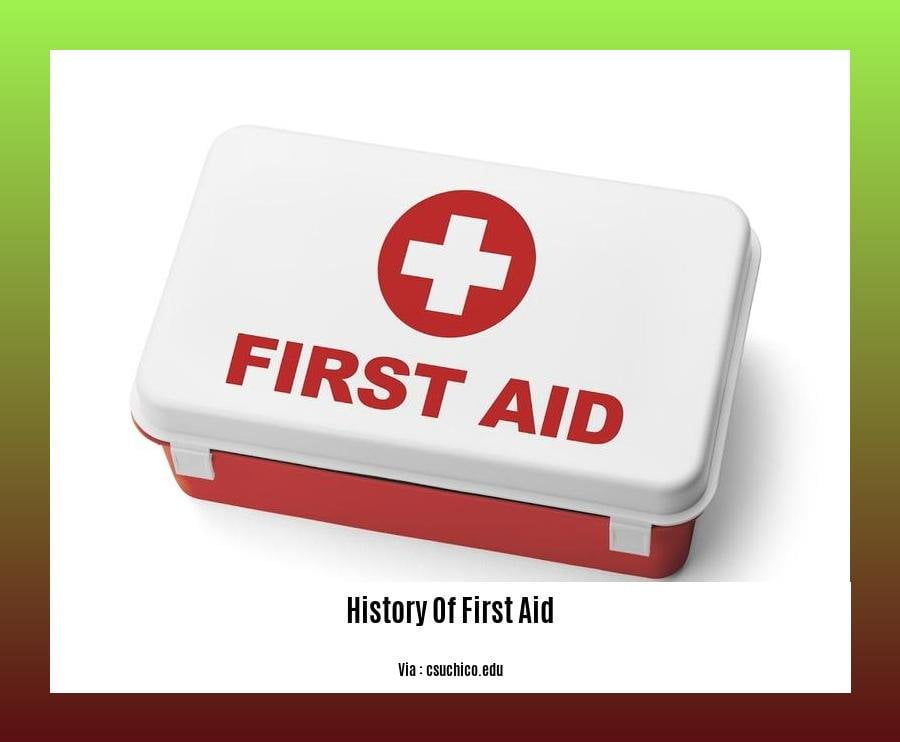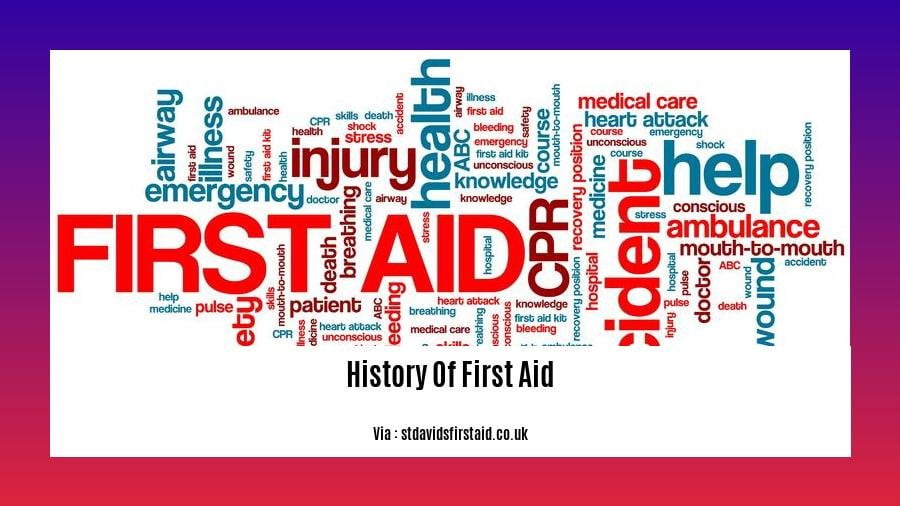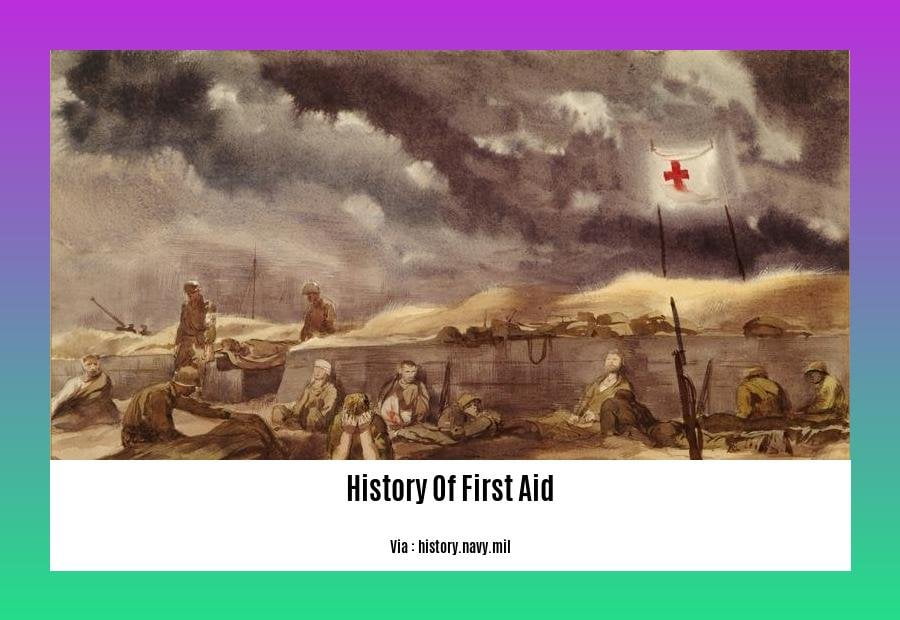Unveiling the History of First Aid: A Journey from Ancient Roots to Modern Practices: Embarking on a captivating exploration of first aid’s rich history, we delve into the intriguing world of ancient healing methods, tracing their evolution through the ages to the cutting-edge techniques employed in contemporary medicine. Join us as we uncover the fascinating stories and remarkable advancements that have shaped the landscape of first aid, transforming it from a rudimentary practice to an indispensable component of modern healthcare.
Key Takeaways:
- First aid is the initial assistance given to someone who has been injured or become ill.
- Its purpose is to prevent further harm and promote recovery.
- Basic first aid includes assessing the situation, performing life-saving actions like CPR, controlling bleeding, immobilizing injuries, and seeking medical help when necessary.
- First aid skills are widely taught and are essential for providing effective help in emergencies.
- First aid services are provided by trained individuals at public events, film sets, and other places where people might get hurt or sick.
History of First Aid

First aid, the prompt assistance given to an injured or ill person before professional medical help arrives, has a rich and fascinating history.
It’s a journey of remarkable progress, from ancient healing practices to modern-day life-saving techniques.
Ancient Roots
In ancient Egypt, healers used bandages to stop bleeding and splints to immobilize injuries. The Greek physician Hippocrates, known as the “Father of Western Medicine,” wrote extensively about treating wounds and injuries. In ancient Rome, the military developed organized systems for providing first aid to injured soldiers.
Middle Ages to Renaissance
During the Middle Ages, first aid was often provided by monks and nuns who had basic medical training. The Renaissance saw a renewed interest in human anatomy and physiology, leading to advances in surgical techniques and wound care.
Industrial Revolution
The Industrial Revolution brought new hazards and injuries, leading to the development of specialized first aid techniques for factory workers and miners. In 1859, the International Committee of the Red Cross (ICRC) was founded, revolutionizing the provision of first aid in war zones.
20th and 21st Centuries
The 20th century witnessed the development of CPR, defibrillators, and other life-saving interventions.
In the 21st century, first aid training has become increasingly accessible, empowering individuals to respond effectively in emergencies.
First Aid Today
Today, first aid is an essential skill taught in schools, workplaces, and communities worldwide. From basic wound care to CPR, first aid training equips individuals to provide immediate assistance, potentially saving lives.
Conclusion
The history of first aid is a testament to human ingenuity and our commitment to helping those in need. It’s a story of continuous innovation, from ancient healers to modern-day first responders, all working to improve the chances of survival and recovery for those facing emergencies.
A meticulous review of the history of football rules is crucial to fully understand the evolution of this beautiful game.
The history of fountains illustrates the profound impact these architectural marvels have had throughout human history.
Immerse yourself in the rich history of Hindustani classical music, an extraordinary art form that has captivated hearts and minds for centuries.
History of First Aid PDF

The history of first aid is a captivating tale of evolution, resilience, and humanity’s remarkable commitment to saving lives. Rooted in ancient healing practices, first aid has traversed centuries, transforming from rudimentary interventions to the sophisticated, life-saving techniques we know today. Delve into this compelling journey as we trace the milestones that shaped the history of first aid in PDF.
Key Takeaways:
Ancient Origins: First aid’s earliest traces can be found in ancient Egypt, where the Ebers Papyrus documented medical knowledge dating back to 1550 BC.
Military Roots: With the advent of organized warfare, the need for battlefield medical care gave rise to military surgeons who provided initial treatment to wounded soldiers.
19th-Century Awakening: The Industrial Revolution brought forth new hazards, leading to the formation of organizations like the Royal Humane Society, dedicated to promoting resuscitation techniques.
Red Cross and First Aid Training: In the late 19th century, Clara Barton’s efforts in the American Civil War highlighted the importance of training individuals in first aid, leading to the establishment of the Red Cross.
Modernization and Standardization: The 20th century witnessed the standardization of first aid practices, with organizations like the International Red Cross and Red Crescent Movement developing guidelines and promoting global harmonization.
Community and Workplace Focus: Today, first aid training has extended beyond medical professionals, becoming a crucial skill for individuals in various settings, including workplaces, schools, and community organizations.
The Journey of First Aid: A Timeline
1872: The St. John Ambulance Association is founded in the United Kingdom, offering first aid training to the public.
1887: Clara Barton establishes the American Red Cross, emphasizing the importance of first aid education and disaster relief.
1908: The first edition of the “First Aid Manual” is published by the American Red Cross.
1960s: Cardiopulmonary resuscitation (CPR) becomes widely recognized as a critical life-saving technique.
1980s: The International Committee of the Red Cross (ICRC) publishes the first edition of the “First Aid Guidelines for Health Care Personnel in Disasters.”
2011: The International Federation of Red Cross and Red Crescent Societies (IFRC) releases the first edition of the “Guidelines for First Aid and Resuscitation.”
The Role of First Aid in Modern Society
In today’s world, first aid plays a crucial role in ensuring the well-being of individuals and communities. From minor injuries to life-threatening emergencies, the ability to provide prompt and effective first aid can make a profound difference in saving lives and reducing the severity of injuries.
Conclusion
The history of first aid is a testament to the remarkable progress made in the field of emergency care. From humble beginnings to the sophisticated practices of today, first aid has evolved into an essential component of healthcare, empowering individuals to respond effectively to medical emergencies and save lives.
Citations:
- History of First Aid
- The History of First Aid and CPR
History of First Aid Ppt
First aid has been an integral part of healthcare since ancient times. Its evolution from rudimentary practices to modern-day scientific methods reflects the collective efforts of dedicated individuals and organizations. Join us as we embark on a historical journey to understand the milestones in first aid’s progression.
Key Takeaways:
Ancient Foundations: The earliest traces of first aid can be traced to ancient Egypt, where the Ebers Papyrus offered medical guidance for wounds and injuries.
Military Medicine: Military surgeons during wars played a pivotal role in developing first aid techniques to treat battle injuries.
Industrial Revolution: The hazards of the Industrial Revolution led to the formation of organizations promoting resuscitation techniques.
Clara Barton’s Influence: Clara Barton’s work in the American Civil War highlighted the need for first aid training, eventually leading to the establishment of the Red Cross.
20th Century Standardization: The 20th century witnessed the standardization of first aid practices through guidelines developed by various organizations.
Modern-Day Expansion: First aid training has expanded beyond medical professionals, with workplaces and schools emphasizing its importance.
Milestones in First Aid History
1872: St. John Ambulance Association is founded, marking a significant step in organized first aid training.
1887: The American Red Cross is established, further promoting first aid education and services.
1908: The First Aid Manual, a comprehensive guide to first aid practices, is published.
1960s: Cardiopulmonary resuscitation (CPR) gains recognition as a vital first aid technique.
1980s: The Red Cross Guidelines for First Aid are developed, providing standardized guidance for first aid responders.
2011: The International Federation of Red Cross and Red Crescent Societies (IFRC) releases updated Guidelines for First Aid and Resuscitation.
Conclusion
First aid has transformed from its humble origins to a sophisticated system that saves countless lives. It has evolved through the dedication of pioneers, the lessons learned in times of war and industrial accidents, and the continuous development of new techniques. Understanding this history helps us appreciate the importance of first aid and the ongoing need for innovation in this vital field.
Citation:
History of First Aid: When was the First Aid Kit Invented?
FAQ
Q1: What prompted the establishment of the first international first aid guidelines?
A1: The First International Geneva Convention, held in the mid-19th century, led to the formation of the Red Cross and the creation of guidelines for providing aid to wounded soldiers on the battlefield, marking the formalization of first aid.
Q2: What was the role of St. John Ambulance in the development of first aid?
A2: St. John Ambulance played a pivotal role in introducing the concept of first aid to the United Kingdom in 1879, emphasizing the importance of prompt and effective assistance in emergencies.
Q3: How did the First International Geneva Convention contribute to the evolution of first aid?
A3: The First International Geneva Convention established guidelines for providing aid to wounded soldiers, laying the foundation for organized and standardized first aid practices in conflict zones.
Q4: Why was the concept of first aid crucial for the Scottish community?
A4: In Scotland, the first aid organization was established in 1882 by St Andrew with the aim of alleviating pain and suffering during wartime and during peacetime, recognizing the need for prompt assistance in various emergency situations.
Q5: How has first aid impacted the global community?
A5: First aid has had a transformative impact worldwide by saving countless lives and reducing suffering through prompt and effective care in emergencies, underscoring its vital role in promoting public health and safety.
- Crypto Quotes’ Red Flags: Avoid Costly Mistakes - June 30, 2025
- Unlock Inspirational Crypto Quotes: Future Predictions - June 30, 2025
- Famous Bitcoin Quotes: A Deep Dive into Crypto’s History - June 30, 2025




![[Phrase Match] Embracing Evolution: A Journey Through Contemporary Dance History contemporary-dance-history_2](https://www.lolaapp.com/wp-content/uploads/2023/12/contemporary-dance-history_2-150x150.jpg)
![[History of EMS Timeline]: A Journey from Humble Beginnings to Sophisticated Healthcare history-of-ems-timeline_2](https://www.lolaapp.com/wp-content/uploads/2023/12/history-of-ems-timeline_2-150x150.jpg)










